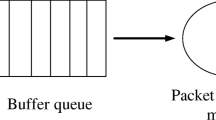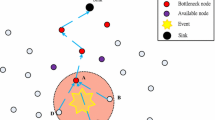Abstract
In wireless sensor networks (WSNs), traffic flow congestion can reduce network performance. We propose a congestion control method for WSNs that use a cache state with a dual threshold in the router buffer to control congestion. In addition, the congestion is controlled by the channel transmission state that is monitored by the queuing variation tendency and the transmission rate. Based on the active queue management mechanism, a dual threshold with the double index random early detection (DI-RED) model is established to improve network performance. We also present the congestion control algorithm of DI-RED model to ensure the perfect actualization. By solving the DI-RED model, a series of channel indicators is obtained, including packet loss rate, average queue length, delay and throughput. Simulation results show that the proposed DI-RED model is more stable and demonstrates better control, which can overcome the parameter sensitivity of the RED mechanism. The proposed model realises a reasonable tradeoff between network performance and packet dropping probability, which effectively avoids degraded network performance caused by pursuing a lower packet dropping probability. The results are important when selecting a congestion control mechanism and parameter settings for WSNs.


















Similar content being viewed by others
References
Boudriga, N. (2014). On a controlled random deployment WSN-based monitoring system allowing fault detection and replacement. International Journal of Distributed Sensor Networks, 10(4), 101496.
Al-Turjman, F. M., Hassanein, H. S., & Ibnkahla, M. (2015). Towards prolonged lifetime for deployed WSNs in outdoor environment monitoring. Ad Hoc Networks, 24(A), 172–185.
Mirsadeghi, M., & Mahani, A. (2015). Energy efficient fast predictor for WSN-based target tracking. Annals of Telecommunications, 70(1–2), 63–71.
Yaghmaee, M. H., Bahalgardi, N. F., & Adjeroh, D. (2013). A prioritization based congestion control protocol for healthcare monitoring application in wireless sensor networks. Wireless Personal Communications, 72(4), 2605–2631.
Chen, J., & Llopis, L. (2011). A survey on quality of service support in wireless sensor and actor networks: Requirements and challenges in the context of critical infrastructure protection. Journal of Network and Computer Applications, 34(4), 1225–1239.
Ghaffari, A. (2015). Congestion control mechanisms in wireless sensor networks: A survey. Journal of Network and Computer Applications, 52(C), 101–115.
Floyd, S., & Jacobson, V. (1993). Random early detection gateways for congestion avoidance. IEEE/ACM Transaction on Networking, 1(4), 397–413.
Reguera, V. A., Fernandez, E. M. G., Paliza, F. A., Godoy, W., & Ribeiro, E. P. (2009). Quality of service for voice over IP in networks with congestion avoidance. Annals of Telecommunications, 64(3–4), 225–237.
Abdel-Jaber, H., Woodward, M., Thabtah, F., & Abu-Ali, A. (2008). Performance evaluation for DRED discrete time queueing network analytical model. Journal of Network and Computer Applications, 31(4), 750–770.
Feng, W. C., Kang, G. S., Kandlur, D. D., & Saha, D. (2002). The BLUE active queue management algorithms. Computer Engineering, 10(4), 513–528.
Akbar, R., Safaei, F., & Modallalkar, S. M. S. (2016). A novel power efficient adaptive RED-based flow control mechanism for networks-on-chip. Computer and Electrical Engineering, 51, 121–138.
Esmaeelzadeh, V., Hosseini, E. S., Berangi, R., & Akan, O. B. (2016). Modeling of rate-based congestion control schemes in cognitive radio sensor networks. Ad Hoc Network, 36(P1), 177–188.
Betzler, A., Isern, J., Gomez, C., Demirkol, I., & Paradells, J. (2016). Experimental evaluation of congestion control for CoAP communications without end to end reliability. Ad Hoc Network, 52, 183–194.
Lim, L. B., & Guan, L. (2010). RED and WRED performance analysis based on superposition of N MMBP arrival process. IEEE International Conference on Advanced Information Networking and Applications, 24, 66–73.
Lim, L. B., & Guan, L. (2011). Controlling mean queuing delay under multi-class bursty and correlated traffic. IEEE International Journal of Computer and System Science, 77(5), 898–916.
Sodhro, A. H., Sangaiah, A. K., Sodhro, G. H., Sekhari, A., Ouzrout, Y., & Pirbhulal, S. (2018). Energy-efficiency of tools and applications on Internet. In Computational intelligence for multimedia big data on the cloud with engineering applications (pp. 297–318).
Wei, H., Huanhao, L., & Wenhui, Y. (2019). Energy optimization for WSN in ubiquitous power Internet of things. International Journal of Computers Communications and Control, 14(4), 503–517.
Suoping, L., Hongchun, S., Zufang, D., & Yongqiang, Z. (2018). Performance analysis of wireless ad-hoc network based on bidirectional full-duplex and saturated state. IET Communications, 12(12), 1422–1430.
Sodhro, A. H., Sodhro, G. H., Guizani, M., Pirbhulal, S., & Boukerche, A. (2020). AI-enabled reliable channel modeling architecture for fog computing vehicular networks. IEEE Wireless Communications, 27, 14–21.
Xuefen, C., & Yingying, Z. (2011). Network analytical model of tandem queuing RED and ERED. Journal on Communications, 32(9), 174–181.
Ghazel, C., & Saidane, L. (2015). Satisfying QoS requirements in NGN networks using a dynamic adaptive queuing delay control method. Procedia Computer Science, 56(1), 225–232.
Marcu, R., Danila, I., Dan, P., Chenaru, O., & Ichim, L. (2017). Message queuing model for a healthcare hybrid cloud computing platfrom. Studies in Informatics and Control, 26(1), 95–104.
Suoping, L., & Zufang, D. (2014). Reconstruction and comparison of discrete-time Erlang loss system. Systems Engineering and Electronics, 36(10), 2076–2081.
Gautam, A., & Choudhury, G. (2018). Performance analysis of DRX mechanism using batch arrival vacation queueing system with N-policy in LTE-A networks. Annals of Telecommunications,. https://doi.org/10.1007/s12243-018-0659-y.
Guan, L., & Awan, I. U. (2007). Discrete-time performance analysis of a congestion control mechanism based on RED under multi-class bursty and correlated traffic. Journal of Systems and Software, 80(10), 1716–1725.
Guan, L., & Awan, I. U. (2007). Stochastic modelling of random early detection based congestion control mechanism for bursty and correlated traffic. IEEE Proceedings Software, 151(5), 240–247.
Acknowledgements
This project is supported by the National Natural Science Foundation of China (Grant: 61663024), the Erasmus+ Programme of European Commission (Grant: 573879), the “Chunhui” Scientific Research Programme of Ministry of Education of China (Grant: Z2016001), and the Hongliu First Class Discipline Development Project of Lanzhou University of Technology.
Author information
Authors and Affiliations
Corresponding author
Ethics declarations
Conflict of interest
The authors declare that they have no conflict of interest.
Additional information
Publisher's Note
Springer Nature remains neutral with regard to jurisdictional claims in published maps and institutional affiliations.
Rights and permissions
About this article
Cite this article
Li, S., Xu, Q., Gaber, J. et al. Congestion Control Mechanism Based on Dual Threshold DI-RED for WSNs. Wireless Pers Commun 115, 2171–2195 (2020). https://doi.org/10.1007/s11277-020-07676-6
Published:
Issue Date:
DOI: https://doi.org/10.1007/s11277-020-07676-6




